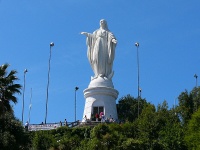
Cerro San Cristóbal is a 2,752-foot (860m) hill rising above central Santiago which, on a clear day, affords magnificent views of the surrounding city, all the way across to the Andes.The easiest way to the top is by funicular, but there is also a teleférico (cable car), bus or hiking path leading up from the bottom through the forested slopes. There are many walkways and at the summit is the 70-foot (22m) high statue of the Virgin Mary to mark where the Pope held a mass in 1987.There is also a zoo on the lower slopes, and picnic sites and two outdoor swimming pools spread throughout the park. The hill is situated within Santiago's biggest open space, the peaceful Parque Metropolitano; it makes for an escape from the hustle of the city. Visitors need a few hours to enjoy the park and on a sunny day the swimming pools are a delight.
Address : Calle Pedro de Valdivia or Calle Pio Nono
The Chilean Museum of Pre-Colombian Art is housed in the old Royal Customs House in Santiago. The collection is impressively large compared to many other museums in a similar vein, and it spans 4,500 years and about 80 pre-Colombian civilisations of South America. The Museo Chileno de Arte Precolombino, as it is known to locals, is a fascinating place to spend a few hours and is a great find for art and archaeology enthusiasts.The exhibits are beautifully curated throughout four rooms set around a central courtyard. The collection provides an informative insight into the cultures of the Incas, Mayans, Aztecs and other proud civilisations of the continent, illustrating their artistic diversity and advancement.It is worth paying extra for a guided tour though, because the labels are not translated into many languages and are not as comprehensive as some might like. Having said that, the museum is a worthwhile attraction in Santiago, especially if travellers are not familiar with the intriguing ancient cultures on display.
Address : Calle Bandera 361
Website : www.precolombino.cl/en
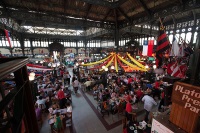
Santiago's colourful Mercado Central, housed in an 1872 wrought iron structure, has a fruit and vegetable market as well as a buzzing fish market where an assortment of glistening fresh seafood is packed onto the tables. Mussels, oysters and clams sit in buckets among an unidentifiable variety of crustaceans and tentacled creatures. The fishmongers demonstrate their skill at gutting and filleting amid a cacophony of frenzied buying. The best time to visit is at lunchtime when a delicious sampling of the wares can be enjoyed in the happily chaotic atmosphere of the central hall.There are many restaurants to choose from and often the smaller ones are the best - and a bit cheaper. Mercado Central can be a bit expensive because its popularity with tourists has grown so be on the lookout for bargains. It is crowded and chaotic, but the seafood is excellent and fresh, the architecture is interesting, and there is a festive feel to the place (partly thanks to the street musicians who frequent it). It is essentially a food market but there are usually some vendors selling souvenirs, jewellery and the like as well. Visitors are warned to stay aware of their possessions because markets of this kind are often targetted by pickpockets.
Address : Corner of Calle Puente and Calle San Pablo
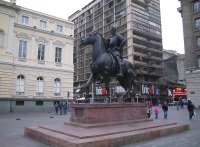
The Plaza de Armas is both the heart of Santiago and the city's historical centre, a square hemmed in by impressive Spanish colonial public buildings, including the 18th-century Cathedral and elaborate main post office that was once the Spanish governors' residence. As with most colonial squares of this kind, and as the name suggests, the Plaza de Armas was designed to be the open space in which the armed forces of the city could gather to parade and to protect Santiago's most important buildings.The square became the hub of administrative, commercial and social life when the city was founded in 1541, and today it remains the centre of life in the city. Never a dull place to be by day, with its constant activity and throngs of people entertained by buskers and local artists, the evenings are just as lively when passers-by can become embroiled in chess games on temporary tables set up under the trees.This square is the point from which all distances are measured in Chile, and the central point for the grid pattern of the streets. Visitors should be aware of their belongings here as it is a popular target spot amongst pickpockets. The square is a useful starting point for sightseeing in Santiago as many attractions are close by.
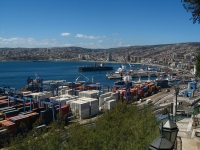
Valparaiso, only 75 miles (120km) from Santiago, has a real bohemian spirit. It is an historic port city; in fact, in the 1800s it was the main shipping hub of the Southern Pacific, which brought wealth, floods of European immigrants, and that deliciously naughty atmosphere found in places frequented by sailors. Valparaiso clings to the steep sides of 45 hills along the coast, a tricky geography that makes epic staircases and quaint old funiculars integral to getting around.The city is a UNESCO World Heritage site and home to a wealth of well-preserved historic architecture, but it is the very modern street art phenomenon which truly sets the place apart. The sheer amount of murals and graffiti, mixed up with grand old buildings, makes the whole city feel like a weird work of art. To add credence to this artsy atmosphere there are musicians busking on seemingly every corner and artists selling their work at improvised stalls all over the picturesque hillside districts.Unsurprisingly, Valparaiso is renowned for its vibrant nightlife and there is a surplus of cool places to eat and drink in the city. Apart from taking in the art, colourful architecture and numerous pubs, travellers should be sure to visit the quirky home of beloved poet Pablo Neruda, which offers glorious views over the city as well as insight into his life.
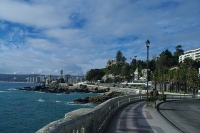
Vina del Mar is a short bus ride from Santiago, right next to Valparaiso; in fact, travellers could be forgiven for thinking the two coastal cities are one and the same. Vina del Mar has a very different character to bohemian Valparaiso though - it is a safer, more manicured city celebrated for its fun resort culture, its malls and its beautiful beaches. Vina del Mar translates as Vineyard of the Sea, and the city's beautiful parks have earned it the romantic nickname of Ciudad Jardin, or Garden City.Pretty Vina del Mar is a popular summer resort and weekend retreat for the wealthy inhabitants of Santiago and the beaches and casinos boom in the peak summer months between December and February. Like neighbouring Valparaiso, the city boasts a rollicking nightlife and a good restaurant scene.Vina del Mar's beaches are its biggest asset but although they are very picturesque they are not always safe for swimming. Visitors should be careful not to underestimate the power of the waves and currents and should obey directives from lifeguards when they are present.
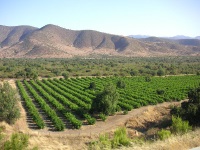
Chilean wine enjoys a good reputation with sommeliers all around the world, with its popularity soaring in the last decade. Central Chile's Mediterranean climate is ideal for vineyards, and some of the best wine comes from the Central Valley, around Santiago. Wine tastings are a popular activity in Santiago, and there are many wineries to choose from. Valle de Maipo, Valle de Casablanca and Valle de San Antonio are the closest to the city, and there are nearly 30 wineries in Valle de Maipo alone. Wine country in Chile stretches for many miles along the coast, from Valle de Elqui in the north to Valle de Malleco in the south.Chilean wine country is an especially beautiful region in the summer, and a great way to explore the area is on bicycles which can easily be hired in nearby towns. Some groups of wineries have banded together to offer established tours along 'wine routes', of which the circuit of the Colchagua Valley is the most popular. Many tour operators in Santiago offer wine tasting packages as well. There is much to delight sommeliers in the region but it is also a fun experience for the uninitiated.

Travel Guide powered by Word Travels, copyright © 2023 Globe Media Ltd. By its very nature information in this travel guide is subject to change at short notice and travellers are urged to verify information on which they're relying with the relevant authorities. Neither Globe Media Ltd nor Travel Vogue can accept any responsibility for any loss or inconvenience to any person as a result of information contained above.